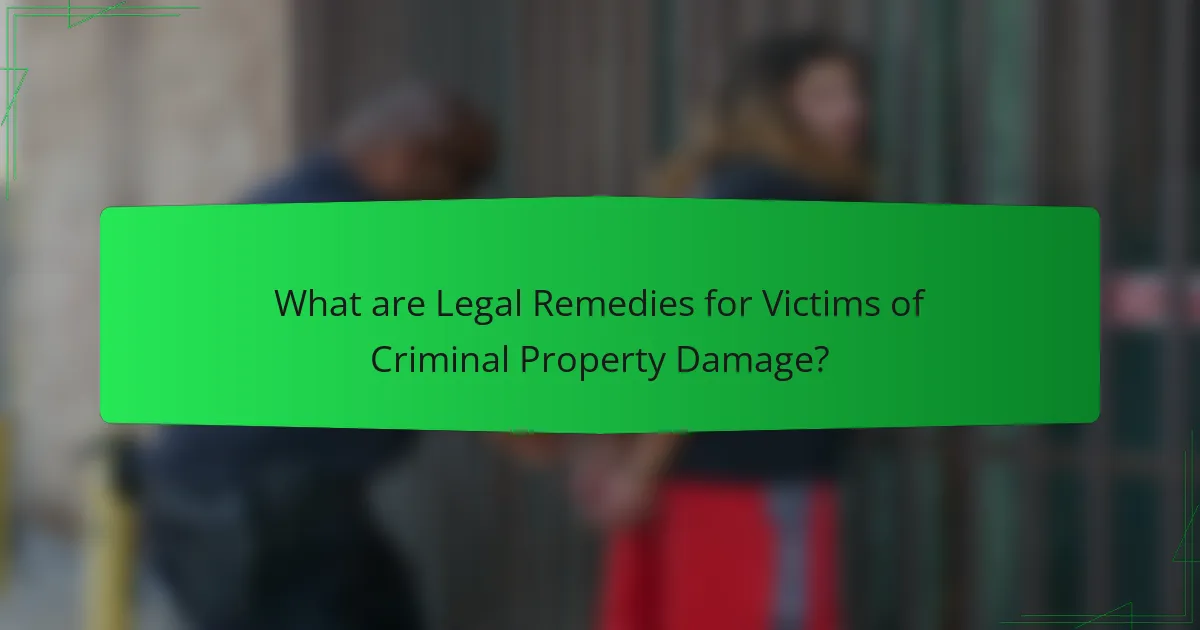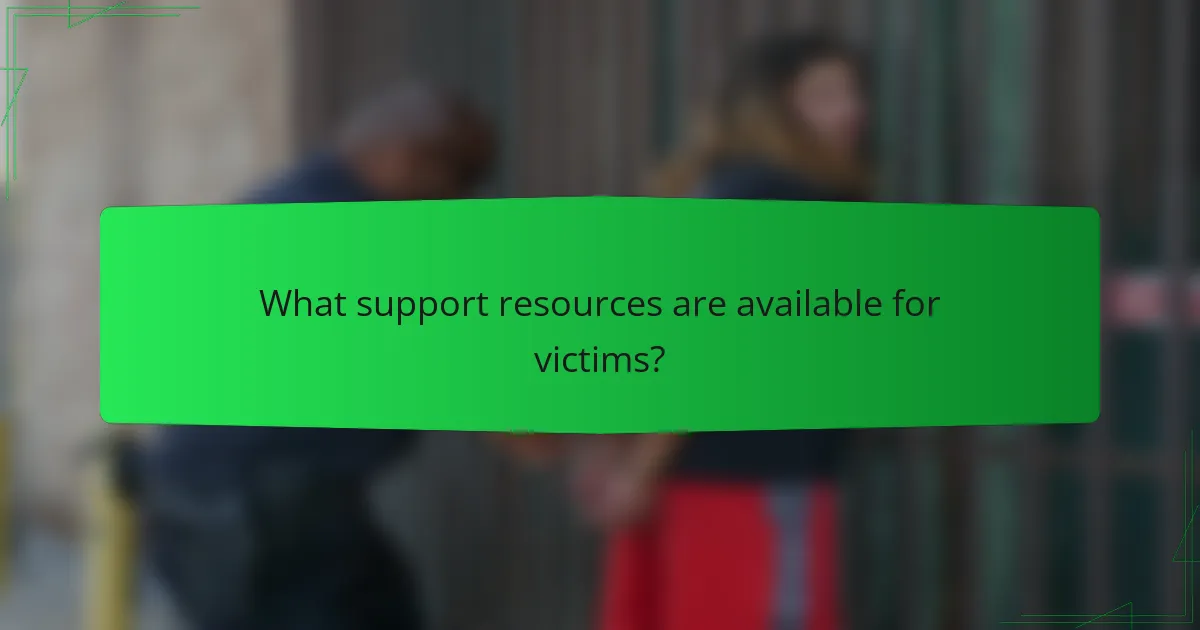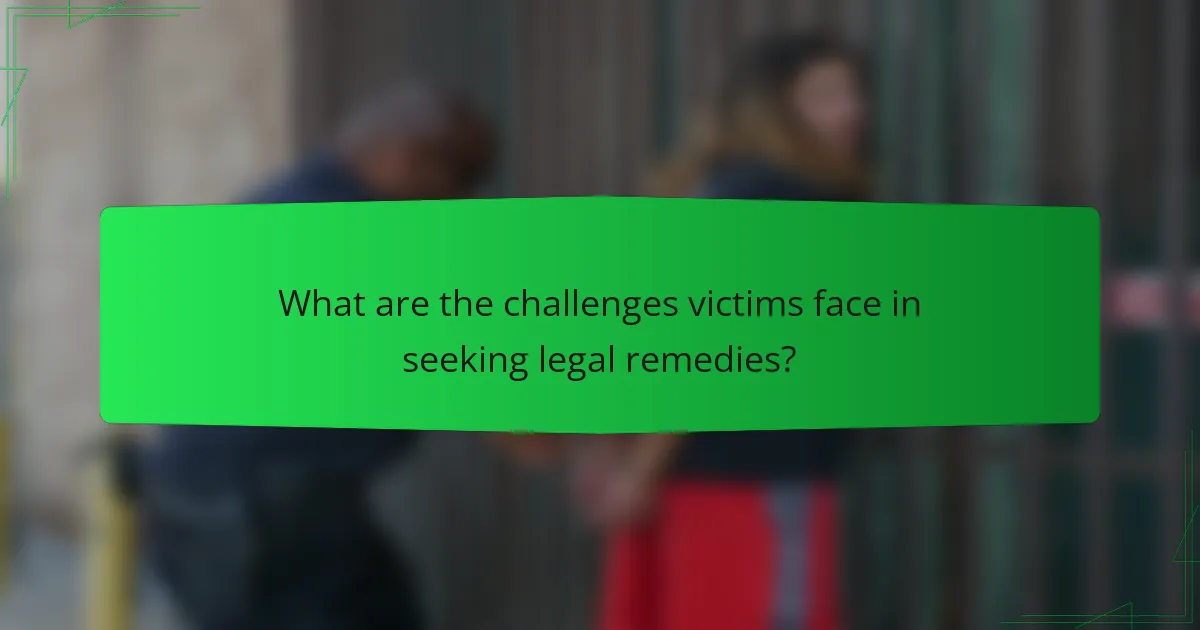Victims of criminal property damage have various legal remedies available to them, including civil lawsuits and restitution during criminal proceedings. They can seek compensation for repairs, replacement costs, and loss of use of their property. Documentation of damages is crucial for supporting claims, and victims can benefit from legal advice and support from organizations that offer free or low-cost services. Additionally, resources such as hotlines, counseling services, and financial assistance programs are available to aid victims in their recovery journey. However, challenges such as lack of awareness, emotional distress, financial constraints, and fear of retaliation may hinder their pursuit of justice.

What are Legal Remedies for Victims of Criminal Property Damage?
Victims of criminal property damage can seek legal remedies through various avenues. They may file a civil lawsuit against the perpetrator for damages. This can include compensation for repairs, replacement costs, and any loss of use of the property.
Additionally, victims can pursue restitution during the criminal proceedings. Courts may order offenders to compensate victims for their losses. Insurance claims can also serve as a remedy if the property is insured.
Victims should document all damages and losses thoroughly. This documentation supports their claims in court or with insurance companies. Legal advice can enhance the chances of recovery. Seeking assistance from legal aid organizations may provide further support.
How can victims seek justice for property damage?
Victims can seek justice for property damage through legal action. They may file a civil lawsuit against the responsible party. This lawsuit can claim damages for the loss incurred. Victims should gather evidence of the damage, such as photographs and repair estimates. They may also report the incident to law enforcement. A police report can support their claim. Insurance claims are another avenue for recovery. Victims can file a claim with their insurance provider. Each state has specific laws regarding property damage claims. Understanding these laws can aid in the process.
What types of criminal property damage are covered under legal remedies?
Criminal property damage covered under legal remedies includes vandalism, arson, and theft-related damage. Vandalism involves the intentional destruction or defacement of property. Arson refers to the willful setting of fire to property, causing significant damage. Theft-related damage occurs when property is damaged during the act of theft. Legal remedies may provide compensation for repair costs and loss of value. Courts may award damages based on the extent of the property damage. Victims can seek restitution from offenders as part of the legal process.
What legal definitions apply to criminal property damage?
Criminal property damage is defined as the intentional destruction or alteration of another person’s property. This includes acts such as vandalism, graffiti, or breaking windows. Legal definitions vary by jurisdiction but generally encompass any willful act that causes harm to someone else’s property. In many states, criminal property damage can be categorized based on the extent of damage, such as minor or significant damage. Proof of intent to damage is often required to establish criminal liability. Additionally, the value of the damaged property can determine the severity of the charges.
What are the different forms of civil actions available?
The different forms of civil actions available include tort claims, breach of contract claims, and equitable actions. Tort claims address wrongful acts that cause harm to individuals or property. Breach of contract claims arise when one party fails to fulfill contractual obligations. Equitable actions seek court orders for specific performance or injunctions rather than monetary damages. Each form of civil action serves a distinct purpose in providing legal remedies.
How do victims initiate a civil lawsuit for property damage?
Victims initiate a civil lawsuit for property damage by filing a complaint in the appropriate court. This complaint outlines the details of the incident and the damages incurred. Victims must gather evidence to support their claims, including photographs and witness statements. They may also need to provide documentation of the property value and repair estimates. After filing, the court will serve the defendant with a copy of the complaint. The defendant then has a specified period to respond. If the case proceeds, both parties may engage in discovery to exchange relevant information. Ultimately, the case may be resolved through negotiation or trial, where a judge or jury will decide the outcome.
What are the key steps in a civil action process?
The key steps in a civil action process include filing a complaint, serving the defendant, and conducting discovery. The plaintiff initiates the process by filing a complaint in the appropriate court. This document outlines the plaintiff’s claims against the defendant. After filing, the court issues a summons that must be served to the defendant, notifying them of the lawsuit.
Once the defendant is served, they must respond to the complaint, usually within a specified time frame. This response may include an answer or a motion to dismiss. Following the initial pleadings, both parties engage in discovery. This phase involves exchanging information, documents, and evidence relevant to the case.
After discovery, the case may proceed to pre-trial motions, where parties can request the court to rule on specific issues. If the case is not resolved, it moves to trial, where both sides present evidence and arguments. Finally, a judgment is issued by the judge or jury, concluding the civil action process.
What compensation options are available for victims?
Victims of criminal property damage have several compensation options available. These include insurance claims, which allow victims to recover losses through their property insurance policies. Victims may also seek restitution from the offender, typically ordered by the court as part of the criminal sentence. Civil lawsuits can be filed against the perpetrator for damages, providing another avenue for compensation. Additionally, some states have victim compensation funds that offer financial assistance for specific losses. Each option is designed to help victims recover financially from their experiences.
How is compensation calculated for property damage?
Compensation for property damage is calculated based on the cost to repair or replace the damaged property. This includes assessing the fair market value of the property before the damage occurred. Insurance policies often dictate the specific methods of valuation. In many cases, actual cash value is used, which factors in depreciation. Replacement cost coverage may also be applicable, covering the full cost to replace the item without depreciation. Documentation of the damage is essential for accurate assessment. Receipts and estimates from contractors can support claims. State laws may also influence compensation calculations.
What types of damages can victims claim in court?
Victims can claim several types of damages in court. These include compensatory damages, which cover actual losses incurred. Compensatory damages can be further divided into economic and non-economic damages. Economic damages encompass medical expenses, lost wages, and property damage. Non-economic damages refer to pain and suffering, emotional distress, and loss of enjoyment of life.
Additionally, victims may seek punitive damages. Punitive damages aim to punish the wrongdoer and deter similar conduct in the future. These damages are awarded when the defendant’s actions are found to be particularly harmful or reckless. The specific types of damages available can vary based on jurisdiction and the nature of the case.

What support resources are available for victims?
Victims have access to various support resources. These include hotlines for immediate assistance, such as the National Domestic Violence Hotline. Counseling services are available to help victims process their experiences. Legal aid organizations offer free or low-cost legal advice and representation. Victim advocacy groups provide support and guidance throughout the legal process. Many communities have local shelters for victims needing a safe place to stay. Additionally, financial assistance programs can help cover costs related to recovery. These resources aim to empower victims and aid in their healing journey.
How can victims access legal assistance?
Victims can access legal assistance through various resources. They can contact legal aid organizations that provide free or low-cost services. Many bar associations offer referral services to connect victims with attorneys. Additionally, victims can seek help from non-profit organizations specializing in victim advocacy. These organizations often provide legal support and guidance. Many states have victim compensation programs that can assist with legal fees. Victims should also consider consulting local law schools, where students may offer legal assistance under supervision. Access to these resources can help victims navigate the legal system effectively.
What organizations provide support for victims of property damage?
Organizations that provide support for victims of property damage include the American Red Cross, which offers disaster relief services. The Federal Emergency Management Agency (FEMA) provides assistance for individuals affected by disasters. Local non-profits often help victims with recovery efforts. State agencies may also offer support programs for property damage victims. Insurance companies can provide financial compensation for covered losses. Community organizations often assist with immediate needs and long-term recovery. Legal aid organizations may help victims understand their rights and pursue claims. These organizations collectively work to support victims through various stages of recovery.
How can victims find pro bono legal services?
Victims can find pro bono legal services by contacting local legal aid organizations. These organizations often provide free legal assistance to those in need. Victims can also visit the American Bar Association’s website for a directory of pro bono programs. Many law schools offer legal clinics where students provide free services under supervision. Local bar associations frequently list attorneys who offer pro bono work. Additionally, victims can seek referrals from community organizations focused on victim support. Resources like the Legal Services Corporation can connect victims with available pro bono services.
What emotional and psychological support is available?
Emotional and psychological support available includes counseling services, support groups, and therapy. These resources help victims process their experiences and emotions. Professional counselors offer tailored guidance and coping strategies. Support groups provide a community for sharing experiences and mutual encouragement. Therapy can address trauma, anxiety, and depression resulting from property damage incidents. Many organizations and nonprofits offer these services at little to no cost. Access to these supports is crucial for recovery and emotional healing.
How can counseling services help victims recover?
Counseling services can help victims recover by providing emotional support and coping strategies. They offer a safe space for victims to express their feelings. This can reduce feelings of isolation and anxiety. Counseling can also facilitate the processing of trauma. Victims learn to manage stress and rebuild their lives. Research indicates that therapy improves mental health outcomes for trauma survivors. A study by the National Institute of Mental Health supports this claim, showing that counseling significantly reduces PTSD symptoms. These services empower victims to regain control over their lives.
What community resources assist victims in coping with trauma?
Community resources that assist victims in coping with trauma include mental health services, support groups, and crisis intervention hotlines. Mental health services provide therapy and counseling tailored for trauma recovery. Support groups offer a space for victims to share experiences and find emotional support. Crisis intervention hotlines provide immediate assistance and guidance to those in distress. These resources are often available through local non-profit organizations and government agencies. Studies indicate that access to these resources significantly improves recovery outcomes for trauma victims.

What are the challenges victims face in seeking legal remedies?
Victims face several challenges in seeking legal remedies. These challenges include lack of awareness about legal rights and processes. Many victims do not understand the legal system. This can lead to missed deadlines for filing claims. Additionally, victims may experience emotional distress, which can hinder their ability to pursue legal action. Financial constraints also pose a significant barrier. Legal fees and costs can be prohibitive for many individuals. The complexity of legal procedures can further discourage victims from seeking remedies. Lastly, victims may fear retaliation from offenders, which can prevent them from coming forward. These factors collectively impede victims’ access to justice.
What barriers do victims encounter in the legal process?
Victims encounter several barriers in the legal process. These include lack of knowledge about legal rights and procedures. Many victims feel intimidated by the complexity of the legal system. Emotional trauma can hinder their ability to participate effectively. Financial constraints may limit access to legal representation. Victims often face societal stigma that discourages reporting incidents. Additionally, fear of retaliation can prevent victims from pursuing justice. According to the Bureau of Justice Statistics, many victims do not report crimes due to these barriers.
How can victims overcome these legal hurdles?
Victims can overcome legal hurdles by seeking legal representation. An attorney can provide guidance on navigating the legal system. They can help victims understand their rights and the processes involved. Victims should gather all relevant evidence to support their claims. This includes photographs, witness statements, and police reports. Filing a timely claim is crucial to avoid missing deadlines. Victims may also access support resources such as victim advocacy programs. These programs can offer emotional support and assistance with legal processes. Engaging with these resources increases the likelihood of a successful outcome.
What best practices should victims follow when pursuing legal remedies?
Victims pursuing legal remedies should document all evidence related to the incident. This includes photographs, witness statements, and any relevant records. They should report the incident to law enforcement promptly. Filing a police report establishes an official record of the crime. Victims must also consult with a legal professional specializing in property damage cases. A lawyer can provide guidance on the legal process and potential compensation.
Additionally, victims should keep a detailed log of all expenses incurred due to the damage. This documentation can support claims for compensation. It is important for victims to understand their rights and available legal options. Being informed can strengthen their case. Lastly, victims should adhere to any deadlines for filing claims or lawsuits. Missing these deadlines can jeopardize their ability to seek remedies.
How can documentation improve a victim’s case?
Documentation can significantly improve a victim’s case by providing concrete evidence of the incident. It helps establish a clear timeline of events, which is crucial for legal proceedings. Detailed records can include photographs, witness statements, and police reports. These documents serve as proof of damages and support the victim’s claims. They also enhance the credibility of the victim’s testimony. In cases of criminal property damage, thorough documentation can increase the likelihood of receiving compensation. According to a study by the National Center for Victims of Crime, well-documented cases have a higher success rate in court.
What steps can victims take to protect their rights during the process?
Victims can take several steps to protect their rights during the legal process. First, they should document all evidence related to the crime. This includes photographs, receipts, and witness statements. Next, victims should report the incident to law enforcement promptly. Filing a police report is crucial for legal proceedings. Additionally, victims should seek legal counsel to understand their rights and options. A qualified attorney can provide guidance on civil actions and compensation claims. Victims may also want to keep a detailed record of all communications with law enforcement and legal representatives. This documentation can support their case. Finally, victims should be aware of any deadlines for filing claims or seeking restitution. Timely action can significantly impact their ability to receive compensation.
Legal remedies for victims of criminal property damage encompass various civil actions, compensation options, and support resources. Victims can pursue civil lawsuits, seek restitution during criminal proceedings, and file insurance claims to recover losses from incidents such as vandalism, arson, and theft-related damage. The article details the steps for initiating legal actions, the types of damages available, and the importance of documentation in supporting claims. Additionally, it highlights the emotional and psychological support resources available to victims, as well as the challenges they may face in navigating the legal system.